With the Channel Nine News reader (on the telly in the camp kitchen at the Bushlands Caravan Park) breathlessly informing us that the record breaking heat was going to be followed by winter cold, wind and rain for a couple of days, we decided camping on the coast might not be our best bet. Our unpowered site was sheltered and fairly quiet despite lots of permanent residents avoiding the ridiculous cost of housing with what amounted to an informal community as one of the upsides of what others might see as emblematic of “housing shortage”. But for us having to use the gas rather than firewood was more of a deal breaker than the $25 camp fee. We had a busy day in the caravan park, writing, emailing, charging batteries, washing clothes, preparing food and making yoghurt before cruising the Ocean Drive loop past Pink Lake (which is no longer pink), the coastal holiday subdivisions and more massive eucalypts growing in the white sands to the spectacular Esperance coast.
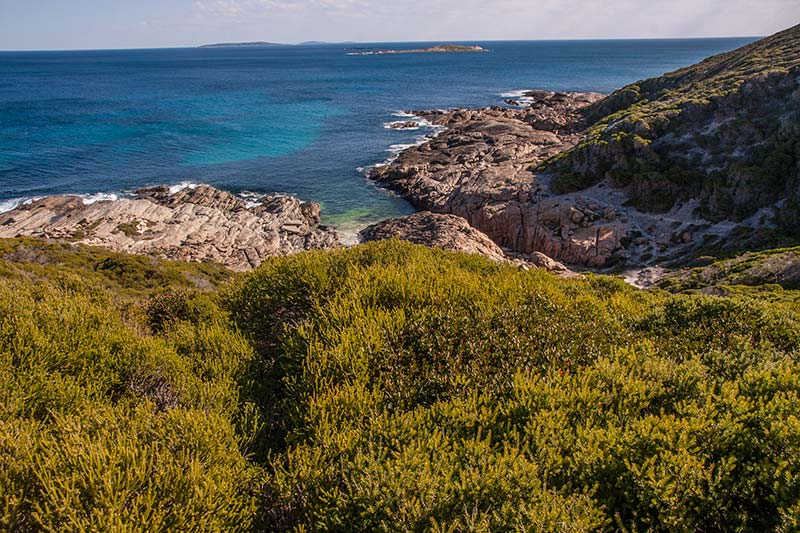
The granite coast with a few of the hundreds of islands of the Recherche Archipelago
Eighteen turbines on the limestone ridge were turning at full speed with the offshore northerly as we took the turn down a very steep 20 0 incline to a carpark below Observation Pt lookout. David’s idea was to get a look along the coast and Recherche Archipelago and select one of the many beaches to have a swim before we headed inland. While he headed for the lookout to get photos, Su took another staircase to a sheltered cover of azure water to have her first dip in southern ocean with air temperature hitting 30 degrees. The water was bracing but like at Ocean and Parry’s Beaches probably 16 degrees! We had lunch sitting on the floor of the observation deck overlooking the spot where the L’Esperance and Recherche sheltered behind Observation Is in 1672 (according the plaque on the pink granite monolith placed in the limestone heathland). David took as many photos of the red flowering Templetonia (one of Venie Holmgren’s favourite WA shrubs that survived the climate and soils of Melliodora) as the spectacular granite outcrops and islands.
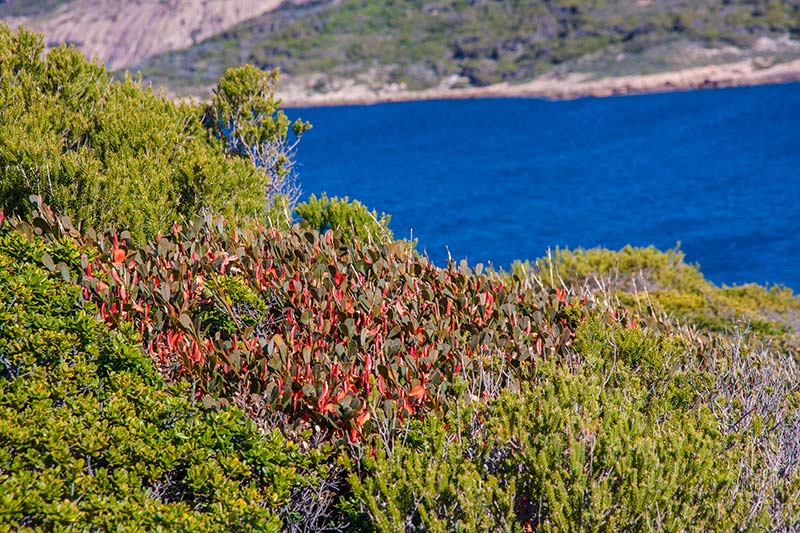
Templetonia in flower on the calcareous cliffs of Observation Point
After lunch Su realised she had left her hat on the beach so got some more exercise and discovered there were 177 steps from the beach to the carpark. The drive into Esperance to shop for supplies to last across the Nullarbor took us past the old wind farm that was operating during our last visit, the sea view mansions that weren’t there and the port with its massive grain, minerals and woodchip export facilities. She did a last minute google search for organic fruit and veg while David took photos of ships leaving port with commodities, yachts and power boat symbols of affluence, a plume of smoke from a bushfire down the coast and people just cooling off in the winter heat, and the massive Norfolk Island Pines that line the foreshore and the streets of the town.
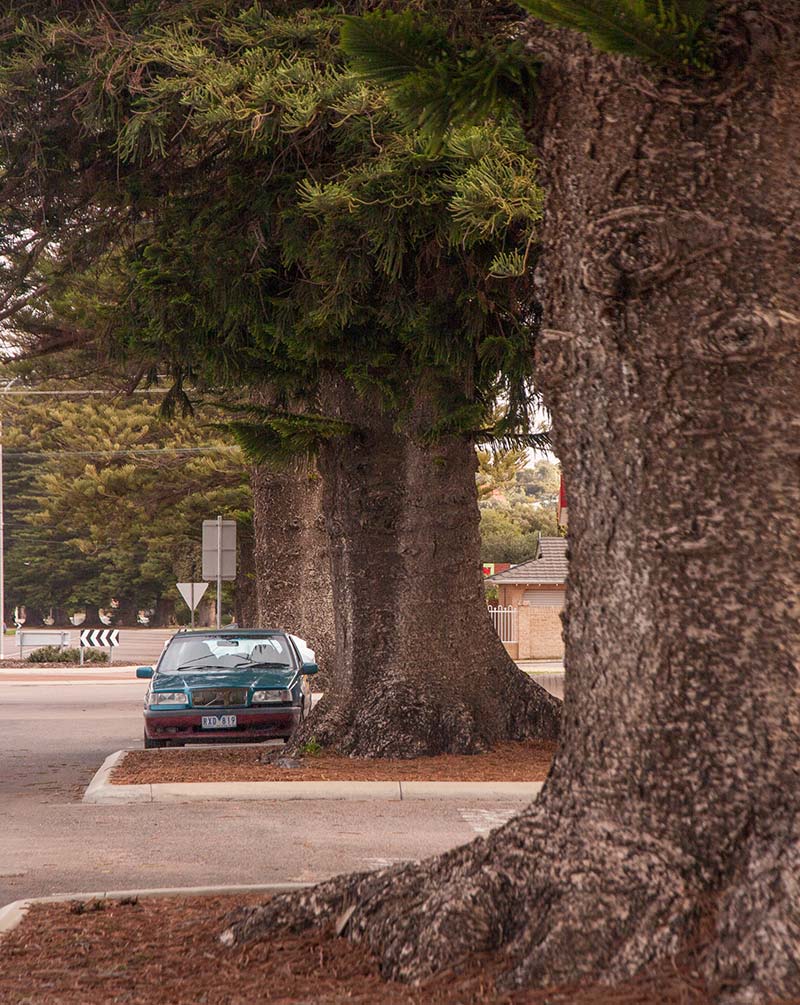
Main street Norfolks possibly destined to be the largest on any coastline before rising sea levels fell them
We had to resort to selecting fresh food for the journey east from the vast selection of non- organic produce in the local IGA but rejected the egg options. A quick stop to get photos of a massive stand of Tuart, and we were on the road north to Norseman in fading light expecting a petrol station on our side of the road. A stop at Gibson Soak to get just 20 litres of (91 Octane) Unleaded turned out to be serendipitous for purchasing two dozen local free range eggs for the slow journey east.
Concern about kangaroos in the dark and declining phone service to access google maps had us select a nature reserve on pure white sand, recently burnt by bushfire. The unburnt spot to get off the track and set up the camper with modest shelter from the forecast wind and rain was next to a dump of car tyres and asbestos. Still we had a campfire with spots of rain and rising humidity reducing the risks and were surprised to be able to pack up in the morning before light showers, walk and photograph the diversity of flowers and regeneration in the burnt heathland, and get going before soaking rain set in.
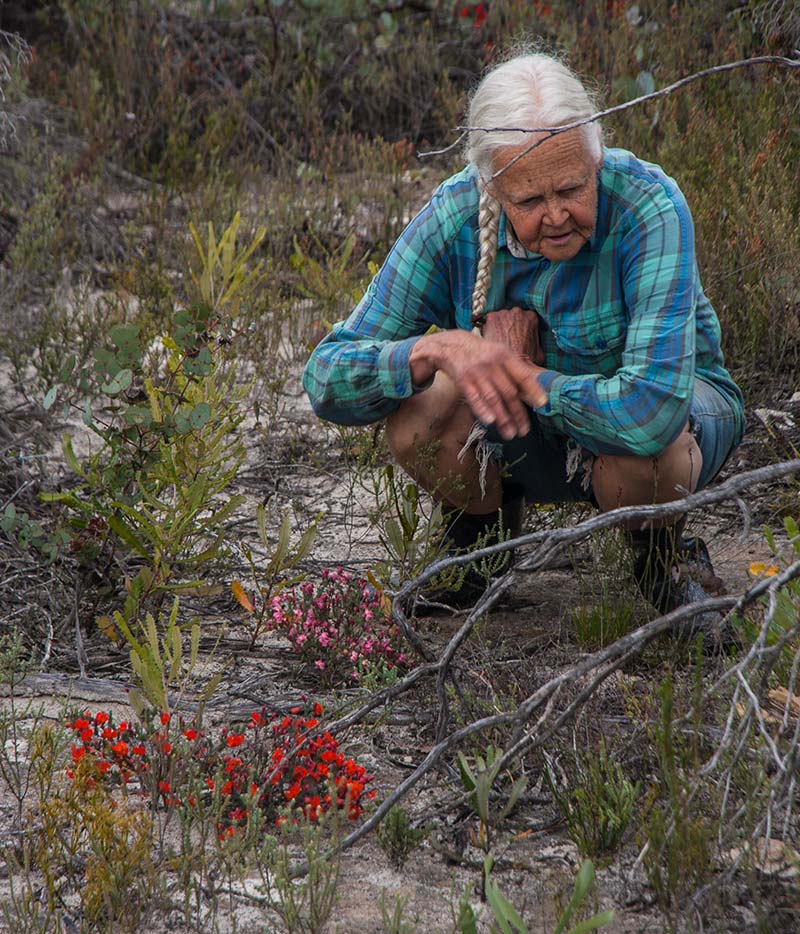
Su inspecting the wildflowers and newly regenerated banksias in the recently burnt heathland
Places in the southwest got 25 to 100mm while most of the wheatbelt seemed to get 12- 25mm – a welcome boost in growth and likely in grain and oil seed yields from millions of hectares of crops, as well as a final flourish for the wildflower season as another important part of the regional economy. The vegetation of the woodlands was radiant in the rain and water was pooling at the foot of Dundas Rock where we stopped for a climb.
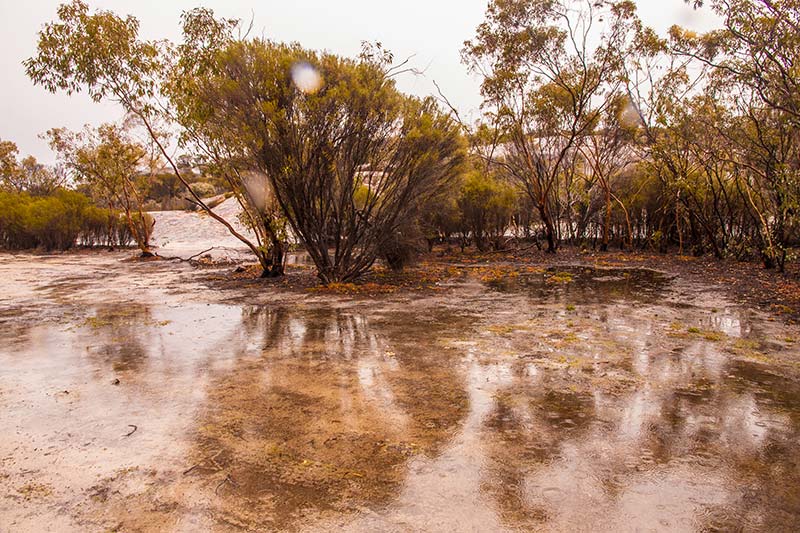
Water pooling on the granitic sand at the foot of Dundas Rock
Contact over the previous days with Graham Cohen, a cousin David hadn’t seen since his youth, had us planning a grey nomad rendezvous in Norseman. The town had much more activity than on our previous visit. We drove past the site of the State Rock Drilling championships where practice runs were underway, were told by the op shop lady that the town was preparing for a big 125th celebration and noted the crowds in the street as we headed for the Full Moon Café again to work while waiting for Graham. After greetings we decided to head out of town to a bush camp at Jimberlana Hill as the sky cleared, rather than use the RV town camp where fires were not an option.
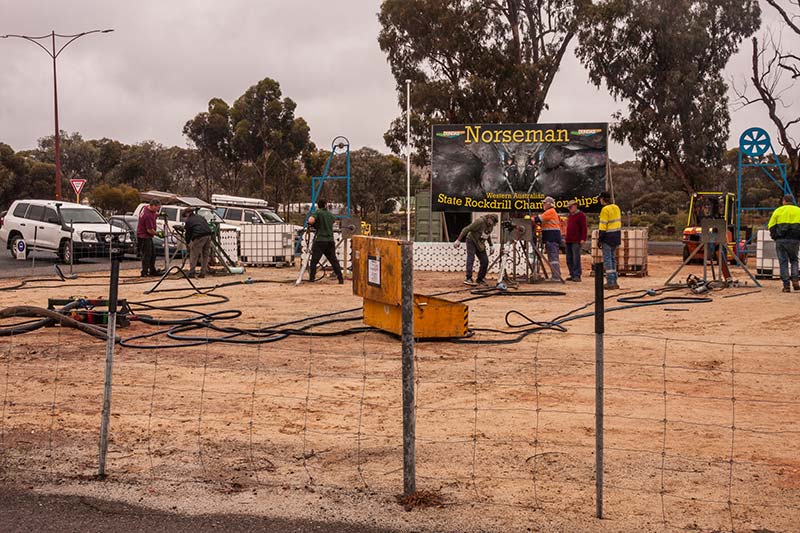
Prep and practice for the rock drilling championships
Su decided to head back to town for the bush dance. After failing the find the bush dance even with the help of locals and Lord Google she returned to join the blokes in sharing stories spanning the last 70 years. Catching up on decades with stories of family and friends, including those passed, and sharing the joys of bush camping were all marks of the good aspects of grey nomad culture that occupied us that evening.
After a late camp breakfast we climbed the hill together appreciating the diversity of western woodlands wildflowers, the views of Lake Cowan and our own health and freedom of choice. The day was spent lolling about, housekeeping, communications and catching up on blogs. Graham’s blog is a brief email missive each day to friends and family unlike ours that has turned into a substantial project, hopefully informing a wider network of people interested in the diversity of places and issues addressed. Graham told us a story about meeting Argentinian cyclists crossing Australia at a bush camp years ago. Hearing that they had a passion for permaculture. Graham noted he had a cousin “into permaculture” but on discovering who the cousin was, the cyclists began treating him like royalty and showed him their Spanish edition of Permaculture: Principles and Pathways Beyond Sustainability. The real nuggets of our conversation, at least for David, were impressions of his parents Jack and Venie from someone 16 yrs older. For Su, meeting someone with a love of the bush, campfires and minimalism was a pleasure even if Graham’s version of minimalism was a little different from ours.
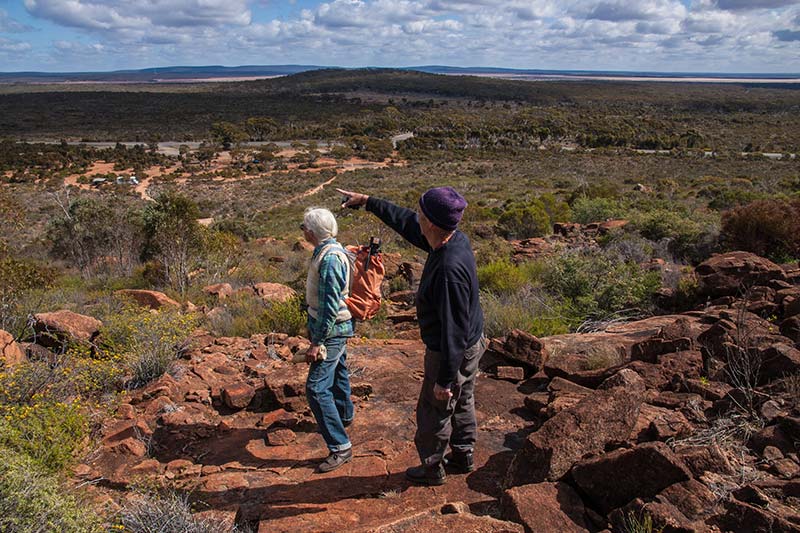
Graham Cohen pointing to features on the western horizon from Jimberlana Hill
Our discussions about attitudes to and impacts on the bush got us thinking about different approaches to living lightly. The bushwalking adage “leave only footprints and take only photos” has been a useful message to lessen the impacts of modern people recreational encounters with nature, especially “pristine nature” of iconic places. But that approach has also been a contributing factor to two more fundamental problems with human/environment relationships. The first is that this conventional approach to conserving nature has contributed to the already strong sense that we are not part of nature and that we only take and have nothing to give other than pollution. The idea that our harvesting of firewood at a camp could be helping to create firesafe groves of trees reminiscent of parks both indigenous and contrived by white civilisation as a pleasant and nurturing place to inhabit is quite foreign to current orthodox approaches to managing natural areas. The thought that our own bodily wastes could be beneficial nutrients or that the seeds of our consumed fruit might naturalise to create food for future travellers is offensive to many.

Eating one’s own road kill; an act of atonement and appreciating nature’s abundances
Clearly the tendency of large numbers of modern humans to visit the most pristine environments that by default are low in nutrients, fragile to animal (including human) impacts and slow to recover is a serious problem. This is especially so on a continent with the most exquisite diversity of ecosystems adapted to low fertility. But the extension of nature conservation protocols developed in the hope of protecting the most special places from hordes of tourists – whether on foot or fossil fuelled – to every bit of vaguely natural vegetation along highways, country roads and around towns, makes little sense. Any place people frequent will be changed by their presence. Efforts to prevent or minimise that change tend to increase environmental impacts elsewhere. So it make sense, from a permaculture perspective, to make use of local firewood (rather than bottled gas) to cook a camp dinner in the outback or regrowth forests, even if vehicle campers should bring wood (and kindling) to the Nullarbor sea cliffs rather than denude what little biomass there is, or that hikers should carry gas or solid fuel stoves in the Tasmanian alpine areas because the available wood is hundreds of years old and very slow to be replenished.
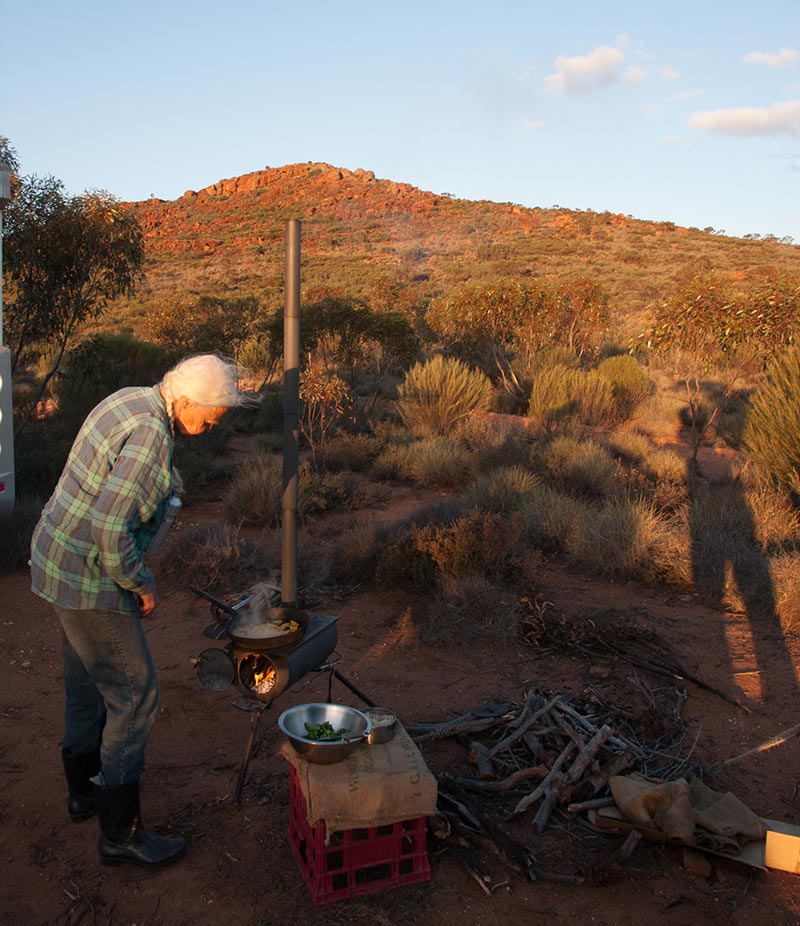
Su cooking on Graham Cohen’s portable stove that allows safe camp cooking in a wider range of weather conditions
We think it also makes sense to “shit in the woods” (the title of a book on the subject) rather than have mobile homes with onboard toilets requiring water and chemicals to be saved up for empting at the closest RV dump site connected to town sewerage systems. Of course there are protocols for shitting in the woods (site away from water and of course bury the deposit). To this Su says use leaves or when none suitable use smooth rocks or sticks. Her pet hate on our 1999 trip and this time round is desiccating toilet paper that takes ages to break down in dry climates. At least if toilet paper is buried with poo it breaks down rapidly helping balance the carbon to nitrogen ratio where other organic matter is not present.
Similarly we think it makes more sense to throw food scraps in the bush (usually in leaf litter under shrubs) than cart it to municipal bins that get added to landfill (generating GHG- intensive methane).
While permaculture practices to minimise environment impact challenge a few environmental orthodoxies, the practice of harvesting wild abundance, be that seaweed or kangaroo is regarded as retrograde due to fears that harvesting will eliminate the natural abundances. This attitude has contributed to the strange and toxic situation where natural abundances are sacred from an environmental perspective but generally worthless economically. Modern people often pride themselves that by protecting whales and old growth trees we are learning the wisdom of indigenous peoples who regarded such entities as their sacred kin. However these and similar resources were also the most energetically and therefore economically potent ones available to traditional peoples. The equivalent for us would be to decide that the Galilee Basin and the NW Shelf gas resources were sacred and beyond economic use, something a long way from even imagination let alone serious consideration.
Two permaculture strategies that guide our camping are: consider the global context, and provide a helping hand to nature.
The first requires us to avoid spreading environmental impacts through the global economic system (the local renewable wood vs global non-renewable gas example).
The second requires us to help nature (mostly improving ability to store water and nutrients) by reducing risk of damaging fire, encouraging growth of succession species or other practices that we can only be confident in doing when we have a good working relationship to nature. In the absence of that we have to focus on minimising impact but not at the cost of causing impact elsewhere. This is called the “tall smokestack syndrome” but that is another story.
<< Previous Chapter — — — Next Chapter >>
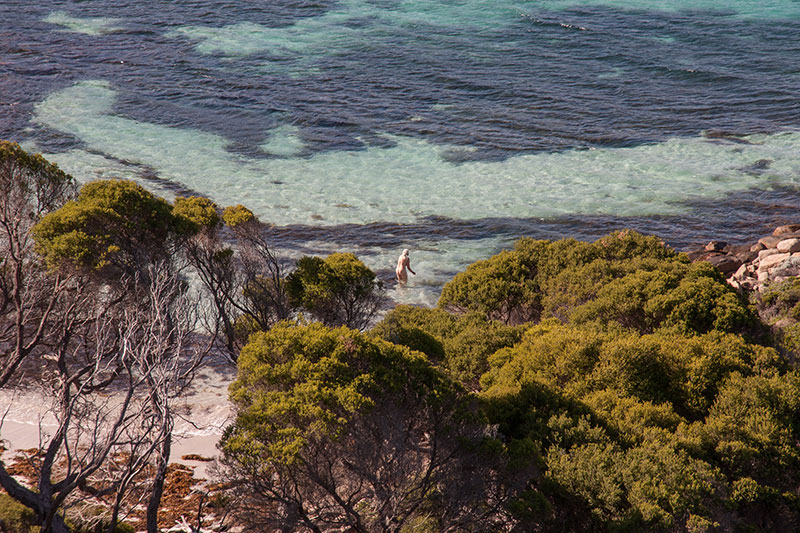
























































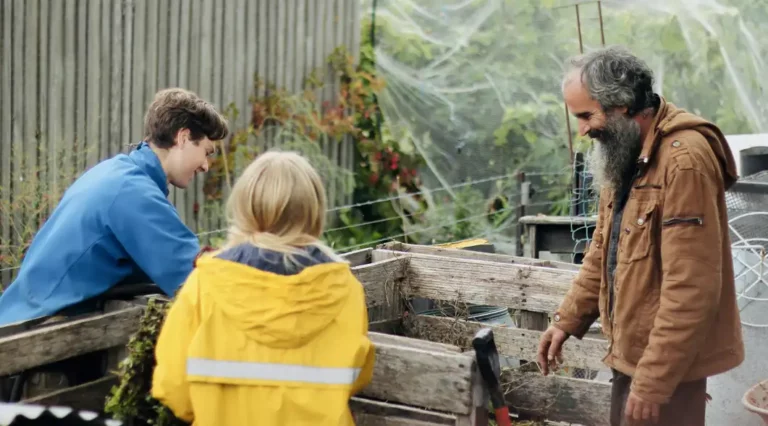
Thank you both for your enlightening comments about how we (humans) can actually interact WITH nature BECAUSE we are part of it. Nature per se has a life span so much longer than ours and will utilise every resource given to it in a way that only nature knows how. My partner and I have travelled parts of Australia as eco-nomads, preferring the bush campfire with respectful use of local deadwood careful not to disturb critter homes where observed and researched; preferring the natural act of squatting and burying our wastes sans paper where possible and discovering with gratitude edible wayside titbits when foraging.